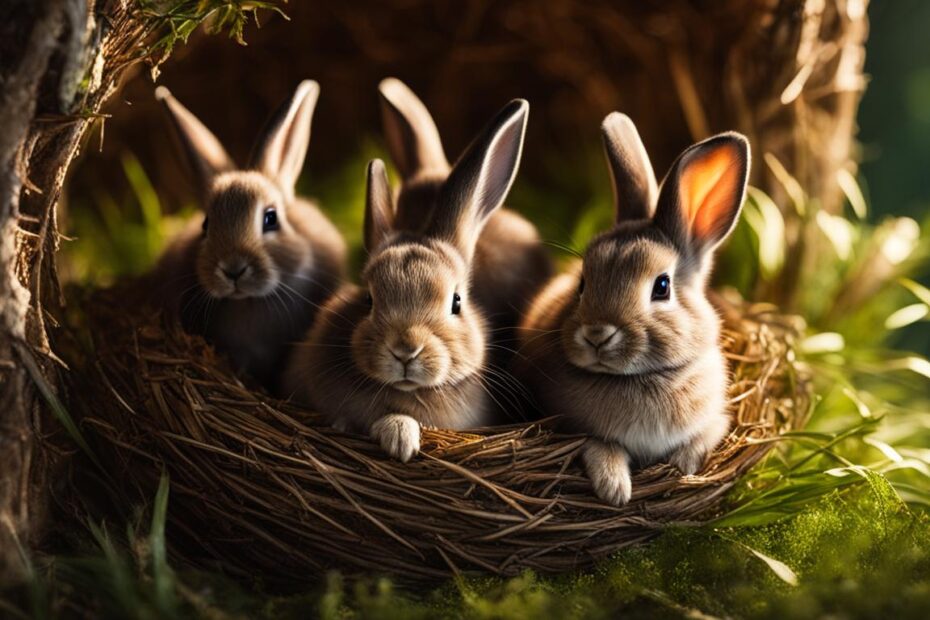Welcome to our article on when rabbits leave the nest. If you’ve ever wondered about rabbit nest abandonment and rabbit nestling behavior, you’ve come to the right place. We’ll explore the fascinating world of how rabbits reproduce, their nesting habits, and what happens when the young rabbits are ready to venture out on their own.
Before we dive into the details, let’s take a moment to appreciate the adorable nature of these furry creatures. Just look at this cute image of a rabbit nestling:
Key Takeaways:
- Rabbits breed from February to September, with the peak occurring between March and May.
- The female rabbit creates a small nest lined with grass and her own fur.
- After about three weeks, the young rabbits will leave the nest.
- It is important not to disturb a rabbit nest, as the mother has not abandoned her young.
- To protect young rabbits in your yard, keep cats and dogs away and be cautious when mowing.
When Rabbits Leave the Nest
Rabbit Reproduction Cycle
Rabbits are fascinating creatures with a unique reproduction cycle. Understanding this cycle is essential for anyone interested in these furry little animals. From the breeding season to the baby rabbits leaving the nest, let’s take a closer look at the rabbit reproduction cycle.
Rabbit Breeding Season
The rabbit breeding season typically takes place from February to September, with the peak occurring between March and May. During this time, rabbits are polygamous and can start breeding as young as six months old. Female rabbits have three litters per year, with an average of four to six young rabbits born per litter.
Baby Rabbits Leaving the Nest
After about three weeks, the young rabbits are ready to leave the nest. At this stage, they are capable of surviving independently. This is an important milestone in the rabbit reproduction cycle as the young rabbits disperse from the nest and begin their own journey in the world.nesting habits of rabbits
To summarize, the rabbit reproduction cycle involves a breeding season that spans from February to September, with a peak between March and May. Female rabbits have three litters per year, and the baby rabbits leave the nest after about three weeks. This natural cycle ensures the continuation of the rabbit population and offers a glimpse into the remarkable world of these fluffy creatures.
Nesting Habits of Rabbits
Rabbits are known for their intricate nesting habits and remarkable parental care. Female rabbits, also known as does, create nests as a safe shelter for their young. These nests are small, shallow depressions dug into the ground and lined with grass and the female’s fur. The top of the nest is cleverly camouflaged with grass and leaves, blending in with the surrounding environment. rabbit parental care
Once the nest is prepared, the female rabbit will visit it twice a day to nurse her young. These visits typically occur in the early morning and evening when there is less activity and fewer potential predators. The female rabbit spends only a short amount of time at the nest, ensuring her presence doesn’t attract attention from predators.
This nesting behavior demonstrates the survival instincts of rabbits. By creating well-hidden nests and limiting their time at the nest, they minimize the risk of their young being discovered by predators. This instinctive behavior increases the chances of the rabbit offspring surviving until they are old enough to leave the nest.rabbit survival instincts
To summarize, rabbits exhibit fascinating nesting habits and display exceptional parental care. The creation of camouflaged nests and the limited time spent at the nest showcase their instinctive survival strategies. Understanding and appreciating these behaviors can give us a deeper insight into the remarkable world of rabbits.
Rabbit Nesting Habits
Table: Rabbit Nesting Habits
| Nesting Behavior | Description |
|---|---|
| Nest Construction | Female rabbits dig small, shallow depressions lined with grass and fur. |
| Nest Camouflage | The top of the nest is covered with grass and leaves to blend in with the surroundings. |
| Nursing Visits | The female rabbit visits the nest twice a day to nurse her young. |
| Brief Presence | The female spends only a short amount of time at the nest to avoid attracting predators. |
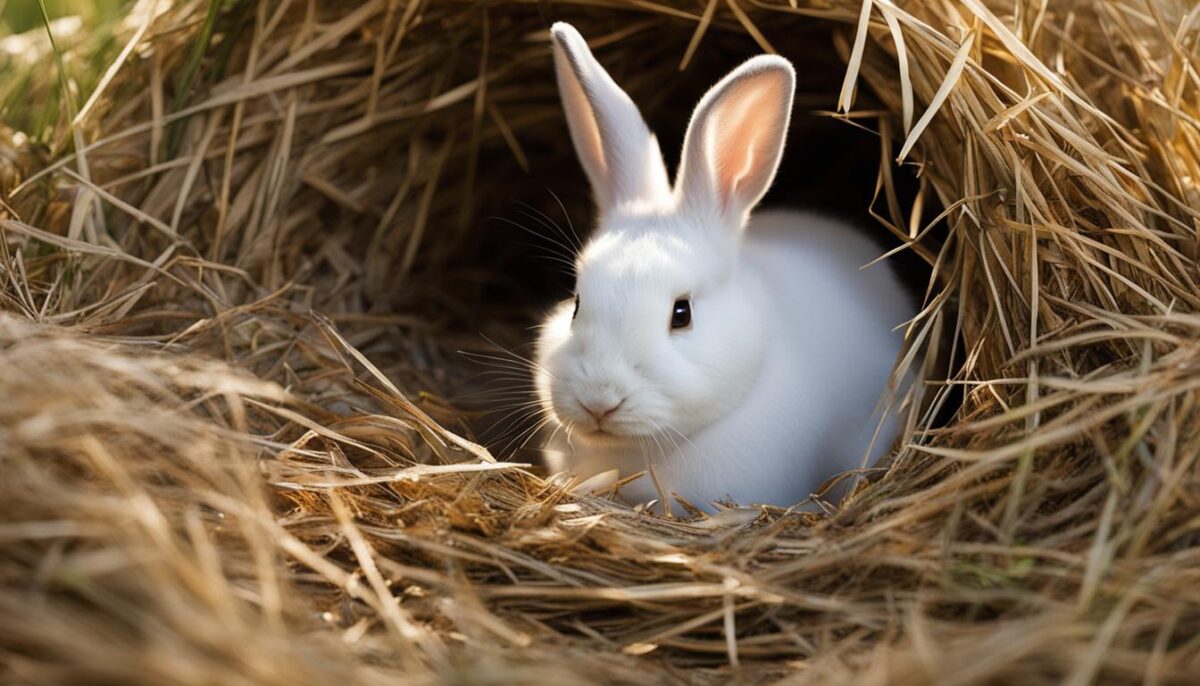
Quote: “Female rabbits meticulously construct nests and employ smart strategies to protect their young from predators.” – Wildlife Expert
Rabbit Nest Abandonment
When it comes to rabbit nest abandonment, it’s essential to understand that a mother rabbit has not actually abandoned her young. Contrary to popular belief, she stays away from the nest to protect her offspring from potential predators. The nest itself is often concealed and rarely do you see the mother rabbit coming and going.
To avoid attracting attention from predators, mother rabbits display a remarkable survival instinct by only visiting the nest briefly, usually in the early morning and evening. By limiting her presence, she reduces the likelihood of attracting predators to the nest. So, if you stumble upon a seemingly abandoned rabbit nest, it’s crucial not to disturb it, as the mother is likely nearby, keeping a watchful eye from a safe distance.hare behavior after birth
The young rabbits, known as leverets, disperse from the nest at around 15-20 days old. By this point, they are independent enough to venture out and explore their surroundings. So, while it may seem like the nest has been abandoned, it’s simply a natural part of the hare’s behavior after birth. It’s best to let nature take its course and not interfere with their development.
Table: Summarizing Rabbit Nest Abandonment
| Key Points | Details |
|---|---|
| Mother Rabbit Behavior | Mother rabbits stay away from the nest to protect their young from predators |
| Survival Instincts | By limiting their presence, mother rabbits reduce the risk of attracting predators |
| Leveret Dispersal | The young rabbits leave the nest at around 15-20 days old |
Remember, observing rabbit nest abandonment can be an intriguing part of understanding these remarkable creatures. By respecting their natural instincts and behaviors, we can ensure their survival and contribute to the delicate balance of our ecosystems.
Rabbit Nest Protection
If you have discovered a rabbit nest in your yard, it is important to take steps to protect the young rabbits. Here are some tips to ensure their safety:
- Leave them in their nest: While it might be tempting to intervene, it is best to leave the young rabbits in their nest. The mother rabbit knows what is best for her babies and will return to care for them.
- Keep cats and dogs away: Create a barrier or keep your pets indoors to prevent them from disturbing the nest or harming the young rabbits.
- Be cautious when mowing: If you need to mow your lawn, be extra careful around the area where the nest is located. Slow down or avoid mowing overgrown lawns altogether to avoid accidentally injuring the young rabbits.
- Modify the habitat: Make your yard less attractive to rabbits by removing brush piles and keeping the grass cut short. This will discourage them from choosing your yard as a nesting location.
By following these steps, you can help protect young rabbits and ensure that they have the best chance of survival in their natural habitat.
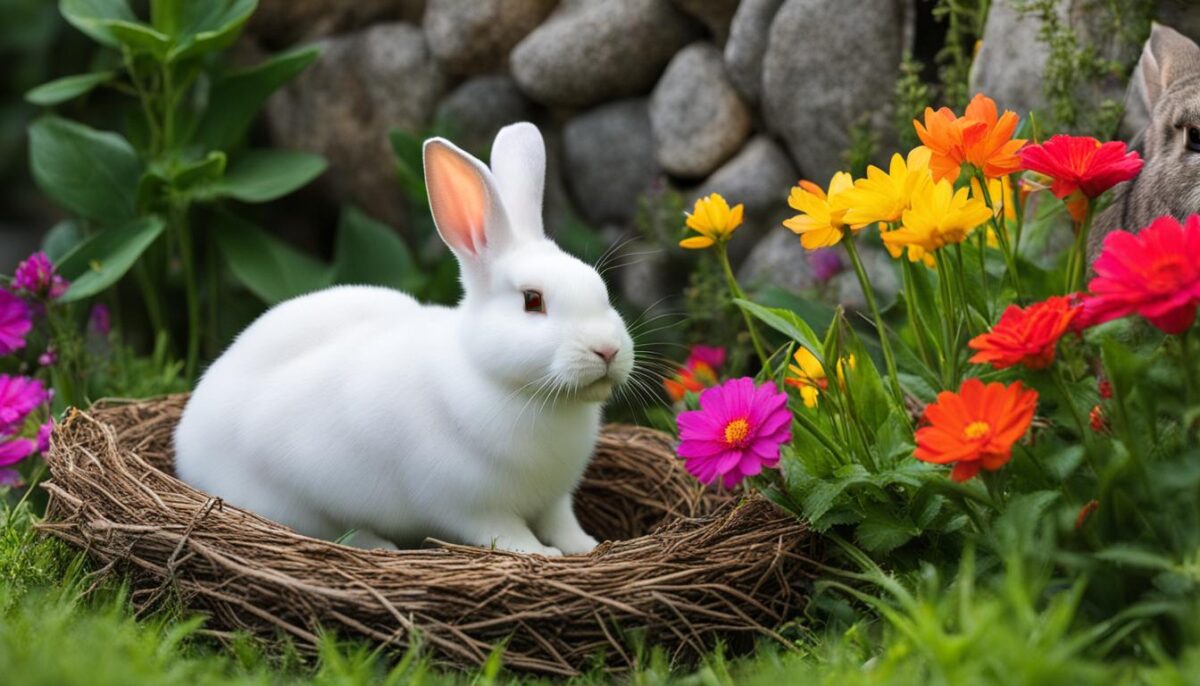
Table: Rabbit Nest Protection Tips
| Tips | Description |
|---|---|
| Leave them in their nest | It is best to leave the young rabbits in their nest, as the mother knows how to care for them. |
| Keep cats and dogs away | Create a barrier or keep your pets indoors to prevent them from disturbing the nest or harming the young rabbits. |
| Be cautious when mowing | Take care when mowing your lawn to avoid injuring the young rabbits, or consider avoiding mowing overgrown areas altogether. |
| Modify the habitat | Make your yard less attractive to rabbits by removing brush piles and keeping the grass cut short. |
Identifying Wild and Domestic Rabbits
When it comes to identifying rabbits, there are distinct differences between wild and domestic varieties. Knowing how to differentiate them can help you understand their behaviors and better appreciate their presence in different environments.
Physical Appearance
Wild rabbits, such as cottontails, typically have brown fur with a white tail, which serves as a useful camouflage in their natural habitats. They have a lean and agile build, optimized for survival in the wild. In contrast, domestic rabbits come in a wide variety of sizes, colors, and patterns. They can range from as small as 2 lbs. to over 20 lbs. Domestic rabbits have been selectively bred by humans for various traits, resulting in a diverse range of appearances. Their ears can stand up, hang down, or be somewhere in the middle.
Behavior
Wild rabbits have developed strong instincts to survive in their natural habitats. They are shy and cautious, relying on their ability to detect threats and quickly escape when necessary. Domestic rabbits, on the other hand, have been acclimated to human interaction and may exhibit more sociable behaviors. They may be more comfortable around humans and can show affection towards their owners.
Habitat
Wild rabbits prefer a natural habitat that provides adequate cover, such as dense vegetation or burrows. They are most commonly found in fields, forests, and grasslands. Domestic rabbits are usually kept as pets and are provided with safe and comfortable indoor or outdoor enclosures. They rely on human caregivers for food, shelter, and protection.
| Wild Rabbits | Domestic Rabbits | |
|---|---|---|
| Physical Appearance | Brown fur with white tail | Wide variety of sizes, colors, and patterns |
| Behavior | Shy and cautious | Potentially more sociable |
| Habitat | Fields, forests, and grasslands | Indoor or outdoor enclosures |
Understanding the differences between wild and domestic rabbits can help us appreciate and respect these fascinating creatures, whether they roam free in the wilderness or share our homes as beloved pets.
Preventing Rabbit Damage to Plants
Rabbits can be cute and furry creatures, but they can also wreak havoc on your garden and plants. To protect your precious vegetation from rabbit damage, there are several effective deterrents you can utilize.
1. Fencing: Installing a two-foot-high chicken wire fence around your garden can create a barrier that rabbits cannot easily breach. Make sure the fence is buried at least six inches deep to prevent rabbits from burrowing underneath.
“A well-constructed fence can be an excellent defense against rabbits. Make sure there are no gaps or openings that rabbits could squeeze through.”
2. Tree Wrap or Plastic Guards: Rabbits have a habit of gnawing on tree bark, which can be detrimental to young trees. Wrapping the trunks with tree wrap or placing plastic guards around them can deter rabbits from nibbling on the bark and causing damage.
- Tree Wrap: Apply tree wrap from the base of the tree to just above the soil line, ensuring it is tight enough to stay in place but not too tight to restrict the tree’s growth.
- Plastic Guards: Place plastic guards around the base of the tree, extending them a few inches above the ground. This physical barrier can prevent rabbits from accessing the bark.
3. Repellents and Scare Devices: There are various commercial rabbit repellents available that can be applied to plants to deter rabbits. These repellents emit odors or tastes that rabbits find unpleasant, discouraging them from feeding on your plants. Additionally, scare devices such as motion-activated sprinklers or ultrasonic devices can startle rabbits and keep them away from your garden.
“Repellents and scare devices can be effective, but it is important to follow the instructions and reapply repellents as directed to ensure their continued effectiveness.”
Table: Comparison of Rabbit Plant Deterrents
| Deterrent | Pros | Cons |
|---|---|---|
| Fencing | Highly effective barrier, long-lasting | Requires installation, may alter garden aesthetics |
| Tree Wrap or Plastic Guards | Specific protection for trees, easy to apply | May need replacement as trees grow, tree wrap can restrict growth if applied too tightly |
| Repellents and Scare Devices | Multiple options available, can cover large areas | Require regular reapplication, effectiveness may vary |
By implementing these preventive measures, you can safeguard your plants from rabbit damage and ensure a thriving garden. Remember to combine multiple deterrents for maximum effectiveness and regularly monitor your garden for any signs of rabbit activity. With a little effort, you can enjoy a beautiful garden free from rabbit-related frustrations.
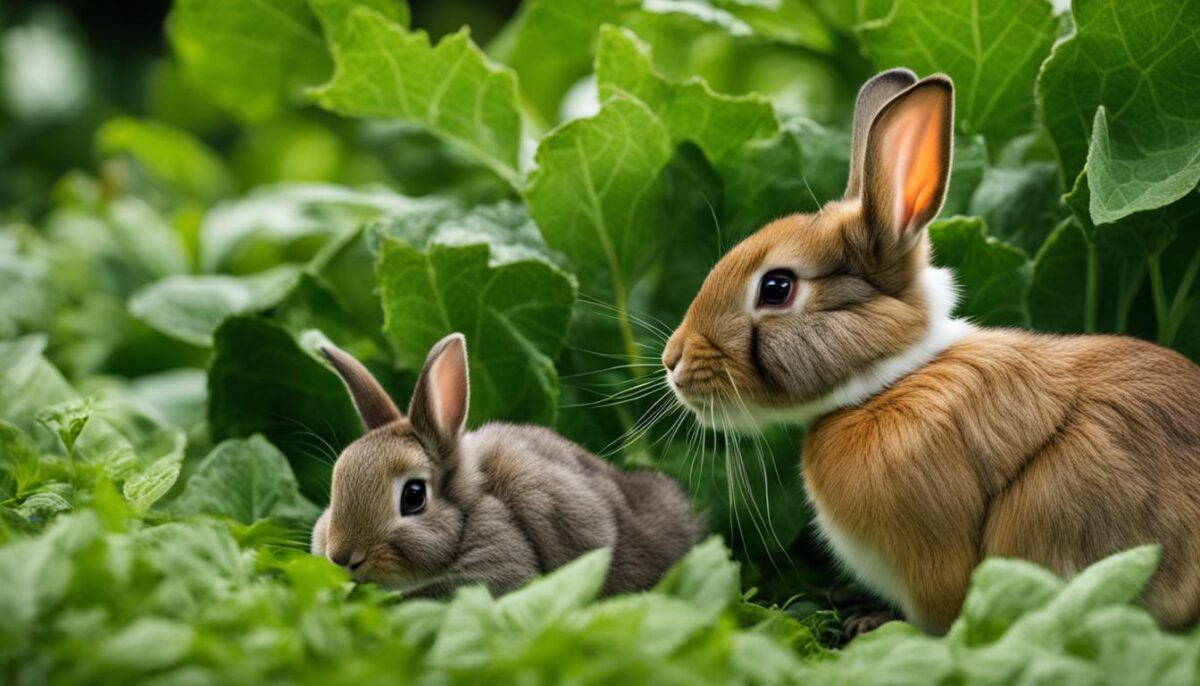
Human Interactions with Wild Rabbits
When encountering a wild rabbit, it is crucial to avoid chasing or handling them. Wild rabbits are highly stressed in human presence and can be harmed by stress. It’s best to observe them from a distance and appreciate their natural behaviors. If you come across an injured or orphaned wild rabbit, it is important to seek professional help. Contact a wildlife veterinarian or rehabilitator who has the expertise to provide proper care and treatment for the rabbit.
Feeding wild rabbits without adequate knowledge can lead to sickness or even death. It is essential to understand their dietary needs and natural foraging behaviors. Feeding them inappropriate food can cause digestive issues and nutritional imbalances. Instead, focus on creating a habitat that supports their natural diet, such as providing diverse vegetation and natural food sources like grasses, herbs, and leafy greens.
“Wild rabbits are important members of our ecosystem, and it is essential that we respect their wild nature. By observing them from afar and providing appropriate support when necessary, we can help ensure their well-being and conservation.”
How to Help Wild Rabbits:
- Observe from a distance and avoid chasing or approaching them.
- If you find an injured or orphaned rabbit, contact a wildlife veterinarian or rehabilitator for proper care.
- Avoid feeding wild rabbits without proper knowledge of their dietary needs.
- Create a habitat that provides natural food sources and vegetation.
- Spread awareness about the importance of respecting wild rabbits and their role in the ecosystem.
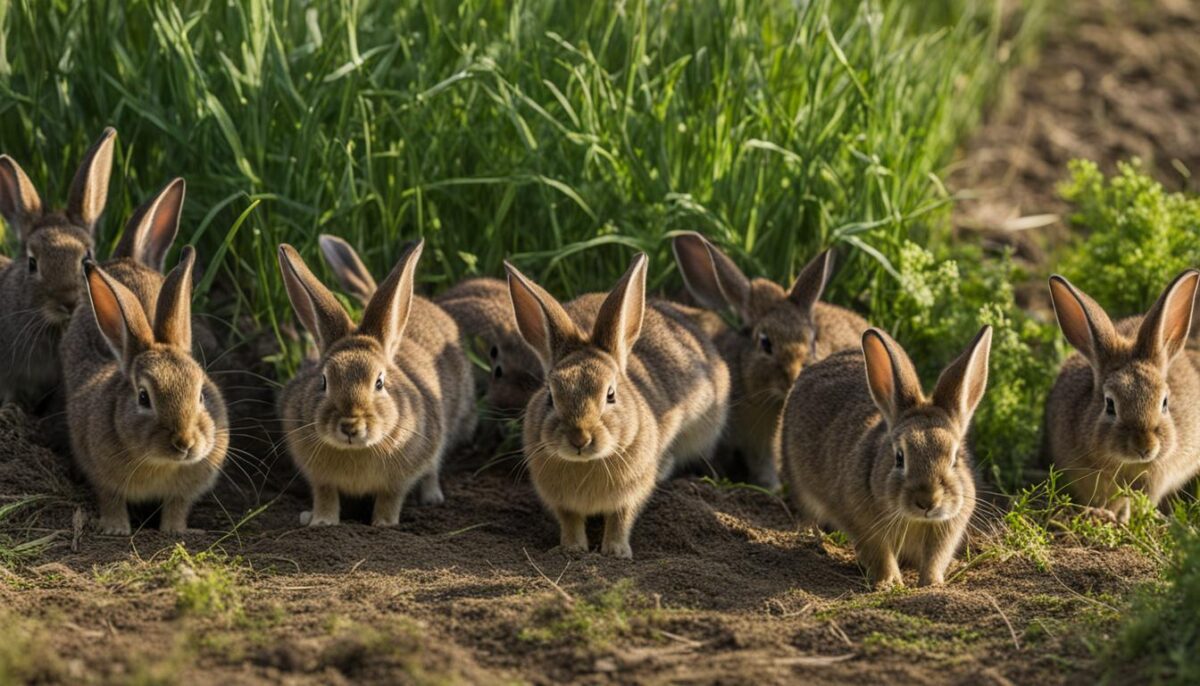
| Threats to Wild Rabbits | Ways to Mitigate |
|---|---|
| Predators | Provide natural hiding places and cover in the habitat. |
| Habitat loss | Preserve and create suitable habitats by planting native vegetation. |
| Human disturbance | Limit human activity near rabbit habitats and avoid chasing or approaching them. |
| Disease | Minimize contact between domestic rabbits and wild rabbits to reduce the risk of disease transmission. |
Conclusion
Wild rabbits are crucial for the health and balance of our ecosystem. They contribute to the fertility of the soil through their grazing habits and serve as an essential source of food for many predators. Understanding and appreciating their role in nature is vital for their survival.
The lifespan of wild rabbits can vary, with some living up to nine years. It is important to respect their natural habitats and refrain from disturbing their nests. Mother rabbits strategically abandon their nests to protect their young from predators, so it is crucial not to interfere.
By taking simple steps to protect and coexist with wild rabbits, we can ensure their continued survival. Creating a safe environment that discourages nesting and avoiding stress-inducing interactions are key. Remember, when encountering injured or orphaned rabbits, it is best to seek professional help from a wildlife veterinarian or rehabilitator.
FAQ
When do rabbits leave the nest?
Young rabbits leave the nest when they are about three weeks old.
Do mother rabbits abandon their nests?
No, mother rabbits stay away from the nest to avoid leading predators to it.
How can I protect young rabbits in my yard?
To protect young rabbits, it is best to leave them in their nest and keep cats and dogs away from the area.
What do wild rabbits look like?
Wild rabbits, like cottontails, are typically brown with white tails. Domestic rabbits come in various sizes, colors, and patterns.
How can I prevent rabbit damage to my plants?
You can use fencing, tree wrap, plastic guards, repellents, and scare devices to deter rabbits from eating plants.
What should I do if I encounter an injured or orphaned rabbit?
It is best to contact a wildlife veterinarian or rehabilitator for assistance.
What role do wild rabbits play in the ecosystem?
Wild rabbits contribute to soil health and serve as a food source for predators.


